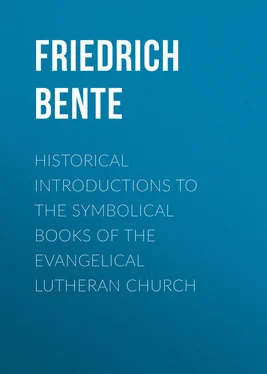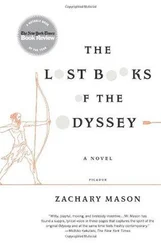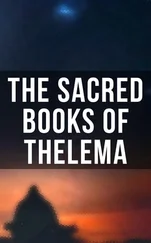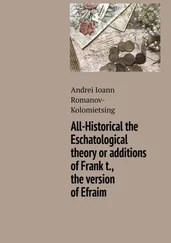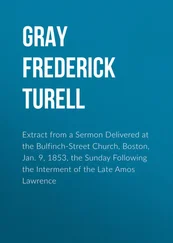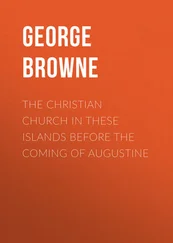Friedrich Bente - Historical Introductions to the Symbolical Books of the Evangelical Lutheran Church
Здесь есть возможность читать онлайн «Friedrich Bente - Historical Introductions to the Symbolical Books of the Evangelical Lutheran Church» — ознакомительный отрывок электронной книги совершенно бесплатно, а после прочтения отрывка купить полную версию. В некоторых случаях можно слушать аудио, скачать через торрент в формате fb2 и присутствует краткое содержание. ISBN: , Жанр: foreign_antique, foreign_prose, на английском языке. Описание произведения, (предисловие) а так же отзывы посетителей доступны на портале библиотеки ЛибКат.
- Название:Historical Introductions to the Symbolical Books of the Evangelical Lutheran Church
- Автор:
- Жанр:
- Год:неизвестен
- ISBN:http://www.gutenberg.org/ebooks/26909
- Рейтинг книги:3 / 5. Голосов: 1
-
Избранное:Добавить в избранное
- Отзывы:
-
Ваша оценка:
- 60
- 1
- 2
- 3
- 4
- 5
Historical Introductions to the Symbolical Books of the Evangelical Lutheran Church: краткое содержание, описание и аннотация
Предлагаем к чтению аннотацию, описание, краткое содержание или предисловие (зависит от того, что написал сам автор книги «Historical Introductions to the Symbolical Books of the Evangelical Lutheran Church»). Если вы не нашли необходимую информацию о книге — напишите в комментариях, мы постараемся отыскать её.
Historical Introductions to the Symbolical Books of the Evangelical Lutheran Church — читать онлайн ознакомительный отрывок
Ниже представлен текст книги, разбитый по страницам. Система сохранения места последней прочитанной страницы, позволяет с удобством читать онлайн бесплатно книгу «Historical Introductions to the Symbolical Books of the Evangelical Lutheran Church», без необходимости каждый раз заново искать на чём Вы остановились. Поставьте закладку, и сможете в любой момент перейти на страницу, на которой закончили чтение.
Интервал:
Закладка:
Historical Introductions to the Symbolical Books of the Evangelical Lutheran Church
I. The Book of Concord, or The Concordia
1. General and Particular Symbols
Book of Concord, or Concordia, is the title of the Lutheran corpus doctrinae, i.e. , of the symbols recognized and published under that name by the Lutheran Church. The word symbol, sumbolon, is derived from the verb sumballein, to compare two things for the purpose of perceiving their relation and association. Sumbolon thus developed the meaning of tessara, or sign, token, badge, banner, watchword, parole, countersign, confession, creed. A Christian symbol, therefore, is a mark by which Christians are known. And since Christianity is essentially the belief in the truths of the Gospel, its symbol is of necessity a confession of Christian doctrine. The Church, accordingly, has from the beginning defined and regarded its symbols as a rule of faith or a rule of truth. Says Augustine: "Symbolum est regula fidei brevis et grandis: brevis numero verborum, grandis pondere sententiarum. A symbol is a rule of faith, both brief and grand: brief, as to the number of words, grand, as to the weight of its thoughts."
Cyprian was the first who applied the term symbol to the baptismal confession, because, he said, it distinguished the Christians from non-Christians. Already at the beginning of the fourth century the Apostles' Creed was universally called symbol, and in the Middle Ages this name was applied also to the Nicene and the Athanasian Creeds. In the Introduction to the Book of Concord the Lutheran confessors designate the Augsburg Confession as the "symbol of our faith," and in the Epitome of the Formula of Concord, as "our symbol of this time."
Symbols may be divided into the following classes: 1. Ecumenical symbols, which, at least in the past, have been accepted by all Christendom, and are still formally acknowledged by most of the evangelical Churches; 2. particular symbols, adopted by the various denominations of divided Christendom; 3. private symbols, such as have been formulated and published by individuals, for example, Luther's Confession of the Lord's Supper of 1528. The publication of private confessions does not necessarily involve an impropriety; for according to Matt. 10, 32 33 and 1 Pet. 3, 15 not only the Church as a whole, but individual Christians as well are privileged and in duty bound to confess the Christian truth over against its public assailants. Self-evidently, only such are symbols of particular churches as have been approved and adopted by them. The symbols of the Church, says the Formula of Concord, "should not be based on private writings, but on such books as have been composed, approved, and received in the name of the churches which pledge themselves to one doctrine and religion." (CONC. TRIGL., 851, 2.)
Not being formally and explicitly adopted by all Christians, the specifically Lutheran confessions also are generally regarded as particular symbols. Inasmuch, however, as they are in complete agreement with Holy Scripture, and in this respect differ from all other particular symbols, the Lutheran confessions are truly ecumenical and catholic in character. They contain the truths believed universally by true Christians everywhere, explicitly by all consistent Christians, implicitly even by inconsistent and erring Christians. Christian truth, being one and the same the world over is none other than that which is found in the Lutheran confessions.
2. The German Book of Concord
The printing of the official German edition of the Book of Concord was begun in 1578 under the editorship of Jacob Andreae. The 25th of June, 1580, however, the fiftieth anniversary of the presentation of the Augsburg Confession to Emperor Charles V, was chosen as the date for its official publication at Dresden and its promulgation to the general public. Following are the contents of one of the five Dresden folio copies which we have compared: 1. The title-page, concluding with the words, "Mit Churf. G. zu Sachsen Befreiung. Dresden MDLXXX." 2. The preface, as adopted and signed by the estates at Jueterbock in 1579, which supplanted the explanation, originally planned, of the theologians against the various attacks made upon the Formula of Concord. 3. The three Ecumenical Symbols. 4. The Augsburg Confession of 1530. 5. The Apology of 1530. 6. The Smalcald Articles of 1537, with the appendix, "Concerning the Power and Supremacy of the Pope." 7. Luther's Small Catechism, omitting the "Booklets of Marriage and Baptism," found in some copies. 8. Luther's Large Catechism. 9. The Formula of Concord, with separate title-pages for the Epitome and the Solida Declaratio, both dated 1580. 10. The signatures of the theologians, etc., amounting to about 8,000. 11. The Catalogus Testimoniorum, with the superscription "Appendix" (found in some copies only). The Preface is followed by a Privilegium signed by Elector August and guaranteeing to Matthes Stoeckel and Gimel Bergen the sole right of publication, a document not found in the other copies we compared. The Formula of Concord is followed by a twelve-page index of the doctrines treated in the Book of Concord, and the list of signatures, by a page containing the trade-mark of the printer. The center of this page features a cut inscribed, "Matthes Stoeckel Gimel Bergen 1579." The cut is headed by Ps. 9, 1. 2: "Ich danke dem Herrn von ganzem Herzen und erzaehle all deine Wunder. Ich freue mich und bin froehlich in dir und lobe deinen Namen, du Allerhoechster. I thank the Lord with all my heart and proclaim all Thy wonders. I am glad and rejoice in Thee, and praise Thy name, Thou Most High." Under the cut are the words: "Gedruckt zu Dresden durch Matthes Stoeckel. Anno 1580. Printed by Matthes Stoeckel, Dresden, 1580."
In a letter dated November 7, 1580, Martin Chemnitz speaks of two Dresden folio editions of the German Book of Concord, while Feuerlinus, in 1752, counts seven Dresden editions. As a matter of fact, the Dresden folio copies differ from one another, both as to typography and contents. Following are the chief differences of the latter kind: 1. Only some copies have the liturgical Forms of Baptism and of Marriage appended to the Small Catechism. 2. The Catalogus is not entitled "Appendix" in all copies, because it was not regarded as a part of the confession proper. 3. In some copies the passage from the Augsburg Confession, quoted in Art. 2, 29 of the Solida Declaratio, is taken, not from the Mainz Manuscript, but from the quarto edition of 1531, which already contained some alterations. 4. Some copies are dated 1580, while others bear the date 1579 or 1581. Dr. Kolde gives it as his opinion that in spite of all these and other (chiefly typographical) differences they are nevertheless all copies of one and the same edition, with changes only in individual sheets. ( Historische Einleitung in die Symbolischen Buecher der ev. – luth. Kirche, p. 70.) Dr. Tschackert inclines to the same view, saying: "Such copies of this edition as have been preserved exhibit, in places, typographical differences. This, according to Polycarp Leyser's Kurzer und gegruendeter Bericht, Dresden, 1597 (Kolde, 70), is due to the fact that the manuscript was rushed through the press and sent in separate sheets to the interested estates, and that, while the forms were in press, changes were made on the basis of the criticisms sent in from time to time, yet not equally, so that some copies differ in certain sheets and insertions." ( Die Entstehung der luth. und der ref. Kirchenlehre, 1910, p. 621.)
However, while this hypothesis explains a number of the variations in the Dresden folio copies, it does not account for all of them especially not for those of a typographical nature.
Читать дальшеИнтервал:
Закладка:
Похожие книги на «Historical Introductions to the Symbolical Books of the Evangelical Lutheran Church»
Представляем Вашему вниманию похожие книги на «Historical Introductions to the Symbolical Books of the Evangelical Lutheran Church» списком для выбора. Мы отобрали схожую по названию и смыслу литературу в надежде предоставить читателям больше вариантов отыскать новые, интересные, ещё непрочитанные произведения.
Обсуждение, отзывы о книге «Historical Introductions to the Symbolical Books of the Evangelical Lutheran Church» и просто собственные мнения читателей. Оставьте ваши комментарии, напишите, что Вы думаете о произведении, его смысле или главных героях. Укажите что конкретно понравилось, а что нет, и почему Вы так считаете.
